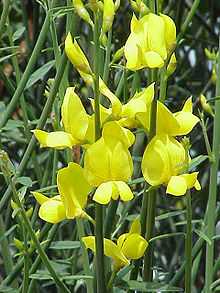Spartium
| Spartium | |
|---|---|
.jpg) | |
| Scientific classification | |
| Kingdom: | Plantae |
| (unranked): | Angiosperms |
| (unranked): | Eudicots |
| (unranked): | Rosids |
| Order: | Fabales |
| Family: | Fabaceae |
| Subfamily: | Faboideae |
| Tribe: | Genisteae |
| Genus: | Spartium |
| Species: | S. junceum |
| Binomial name | |
| Spartium junceum L. | |
Spartium junceum (syn. Genista juncea), known as Spanish broom or weaver's broom, is a species of flowering plant in the family Fabaceae, native to the Mediterranean in southern Europe, southwest Asia and northwest Africa,[1] where it is found in sunny sites, usually on dry, sandy soils. It is the sole species in the genus Spartium, but is closely related to the other brooms in the genera Cytisus and Genista.
The Latin specific epithet junceum means "rush-like", referring to the shoots, which show a passing resemblance to those of the rush genus Juncus.[2]

Description
S. junceum is a vigorous, deciduous shrub growing to 2–4 m (7–13 ft) tall, rarely 5 m (16 ft), with main stems up to 5 cm (2 in) thick, rarely 10 cm (4 in). It has thick, somewhat succulent grey-green rush-like shoots with very sparse small deciduous leaves 1 to 3 cm long and up to 4 mm broad. The leaves are of little importance to the plant, with much of the photosynthesis occurring in the green shoots (a water-conserving strategy in its dry climate). The leaves fall away early.[3] In late spring and summer shoots are covered in profuse fragrant yellow pea-like flowers 1 to 2 cm across. In late summer, the legumes (seed pods) mature black and reach 8–10 cm (3–4 in) long. They burst open, often with an audible crack, spreading seed from the parent plant.
Invasive species
Spartium junceum has been widely introduced into other areas, and is regarded as a noxious invasive species in places with a Mediterranean climate such as California and Oregon, Hawaii, central Chile, southeastern Australia, the Western Cape in South Africa and the Canary Islands and Azores.[1][4] It was first introduced to California as an ornamental plant.[4][5]
Uses
The plant is used as an ornamental plant in gardens and in landscape plantings. It has gained the Royal Horticultural Society's Award of Garden Merit.[6]
In Bolivia and Peru, the plant is known as retama,[1] and has become very well established in some areas. It is one of the most common ornamental plants, often seen growing along sidewalks in La Paz.[citation needed]
Retama has made its way into the ethnobotany of the indigenous Aymara and Quechua cultures.[citation needed]
The plant is also used as a flavoring, and for its essential oil, known as genet absolute.[1][7] Its fibers have been used for cloth and it produces a yellow dye.[7][8]
References
- ↑ 1.0 1.1 1.2 1.3 GRIN Species Profile
- ↑ RHS A-Z encyclopedia of garden plants. United Kingdom: Dorling Kindersley. 2008. p. 1136. ISBN 1405332964.
- ↑ Jepson Manual Treatment
- ↑ 4.0 4.1 US Forest Service Fire Ecology
- ↑ Element Stewardship: S. junceum
- ↑ "RHS Plant Selector - Spartium junceum". Retrieved 04 June 2013.
- ↑ 7.0 7.1 FAO
- ↑ botanical.com
External links
| Wikimedia Commons has media related to Spartium junceum. |